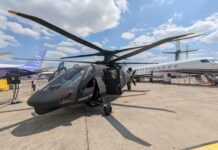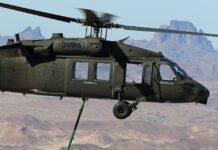Lockheed Martin’s Sikorsky business has received a USD 6 million (EUR 5.5 million) award from the US Defense Advanced Research Projects Agency (DARPA) to install the company’s Matrix flight autonomy system onto the US Army’s experimental fly-by-wire UH-60M Black Hawk helicopter, Lockheed Martin announced on 14 October 2024.
Designated MX, the upgraded Black Hawk will enable the US Army Combat Capabilities Development Command (DEVCOM) to test and evaluate a wide range of autonomy capabilities, from single pilot operation to fully uncrewed flight.
Sikorsky will integrate the Matrix system into the MX helicopter in 2025. The aircraft will enable DEVCOM to explore and mature the practical applications and potential concepts of operations of a scalable autonomy system, as well as allow the evaluation of different sensor suites to perceive and avoid threats, obstacles and terrain.
The Matrix autonomy system forms the core of DARPA’s Aircrew Labor In-cockpit Automation System (ALIAS) programme. As part of ALIAS in 2020, Sikorsky provided the hardware and engineering support to add fly-by-wire flight controls to the MX aircraft. When combined with the Matrix autonomy system, the US Army’s MX aircraft will be a near-exact copy of Sikorsky’s UH-60A fly-by-wire Optionally Piloted Black Hawk helicopter: the company’s flying lab that made its first fully autonomous flight in 2018 and which has tested Matrix autonomy over hundreds of flight hours.
With 14 October 2024 being the opening day of the 2024 Association of the US Army (AUSA) conference in Washington, DC, Lockheed Martin took the opportunity to demonstrate its Matrix-enabled Optionally Piloted Black Hawk in real time. With the Optionally Piloted Black Hawk located at Bridgeport Municipal Airport in Connecticut, Lockheed Martin executives showed on large screen displays on the AUSA show floor how the aircraft, being directed from a tablet device via an encrypted datalink, could be instructed to take off and perform a representative uncrewed logistics mission in a contested environment before coming back in to land. Although two aircrew were on board the aircraft for the flight – in order to comply with Federal Aviation Administration regulations – they did not touch the controls, while a Lockheed Martin technician at the show communicated with the control tower at Bridgeport Airport through a headset. The demonstration ably showcased the Optionally Piloted Black Hawk’s autonomous flight and the fact that whoever directs it does not require piloting skills beyond familiarity with the controls on the tablet.

“Autonomy-enabled aircraft will reduce pilot workload, dramatically improve flight safety, and give battle commanders the flexibility to perform complex missions in contested and congested battlespace, day or night in all weather conditions,” Rich Benton, Sikorsky vice president and general manager, was quoted as saying in a company press release. “Soldiers will rely on Black Hawk helicopters into the 2070s, and modernising the aircraft today will pay dividends for decades across Army Aviation’s current and future aircraft.”
In July 2024 Sikorsky and DARPA demonstrated to US military service personnel and senior US Department of Defense officials how, as with the demo on 14 October, the Optionally Piloted Black Hawk can easily be flown and controlled by either an operator in the cabin or on the ground by entering highlevel mission goals via a tablet. These demonstrations built on autonomous flights at Project Convergence 2022, when Sikorsky and DARPA showed the US Army how the Optionally Piloted Black Hawk, operating without humans on board, could safely and reliably perform internal and external cargo resupply missions.
The Matrix autonomy system, meanwhile, has been demonstrated on 10 different kinds of aircraft, which have included a Group 3 unmanned aerial vehicle, a medium cargo aircraft and a fighter.












